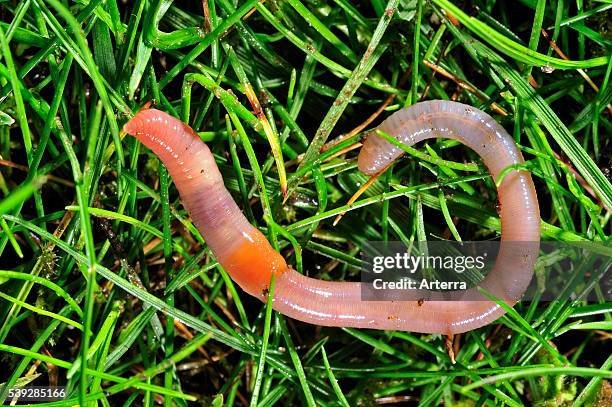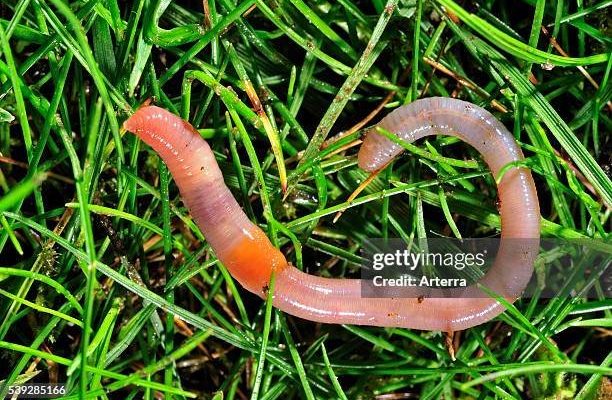
Imagine your garden as a bustling city, with earthworms as the unsung workers who keep everything running smoothly. They’re not just squirmy nuisances; they play a crucial role in breaking down leaf litter, compost, and other organic materials. In this article, let’s explore the different types of earthworms you might find in your garden and how they contribute to making your plants thrive.
1. Nightcrawlers (Lumbricus terrestris)
Nightcrawlers are the heavyweights of the earthworm world, often growing up to 8 inches long! If you’ve ever gone fishing, you might recognize them as the preferred bait for many anglers. These guys are big and robust, with a dark brown or purple hue that helps them blend into the soil.
You might be wondering why they’re so special. Well, nightcrawlers are known for their ability to burrow deep into the earth, bringing oxygen to the soil and creating channels that help water drain better. Think of them as the underground plumbers of your garden! They mainly feed on decaying plant matter, turning it into rich humus as they digest it. This process not only improves soil fertility but also enhances the structural quality of your garden soil.
Their activity is most noticeable during the evening or after a rain when they come to the surface. So, if you see them wriggling about after a downpour, that’s a good sign! It means they’re out aerating the soil and helping your plants grow.
2. Red Wigglers (Eisenia fetida)
Red wigglers are the superheroes of composting. If you ever want to start a compost bin in your backyard, these are the earthworms you want to invite to the party! They are relatively small, typically around 3-4 inches long, and boast a bright reddish-brown color.
What makes red wigglers special? They thrive in organic waste and love to munch on decomposing food scraps. This means they can efficiently turn your kitchen waste into nutrient-rich compost. Imagine throwing your vegetable peels, leftover fruits, and coffee grounds into a compost bin, and having these little guys transform that mess into a rich soil amendment. It’s like having nature’s recycling crew right in your backyard!
They tend to stay in the topsoil, which means they’re always in the best position to help break down materials. So, if you’re looking to boost your garden’s fertility, consider adding a few red wigglers to your compost pile. They’ll not only enhance the soil but also help reduce waste.
3. Asian Jumping Worms (Amynthas spp.)
Asian jumping worms are a relatively new player in the earthworm game. You might not have encountered them yet, but they’re causing quite a stir among gardeners. These worms can be identified by their distinct and somewhat alarming habit of jumping or wiggling when disturbed, which is where they get their name.
Now, here’s the kicker: while they can be effective in breaking down organic material, they tend to be a lot more aggressive than other species. This means they can outcompete local earthworm populations, potentially leading to soil degradation. They thrive in rich, loose soils and can rapidly multiply, which can be problematic for native ecosystems.
If you spot these jumpers in your garden, it’s a good idea to monitor their population. While they can contribute to soil health, balance is key. You might need to think about maintaining a healthy mix of worm species to ensure your garden remains thriving.
4. Brandling Worms (Eisenia andrei)
Brandling worms, also sometimes called “tiger worms,” are another type of composting champ. These worms are typically around 3-4 inches long and feature a distinct striped pattern that makes them look quite appealing. They thrive in compost heaps, manure piles, and even under leaf litter.
Their job is simple but vital: they munch on decomposing organic material, helping to speed up the composting process. By breaking down this waste, they enrich the soil with nutrients that your plants desperately need. It’s like having a natural fertilizer factory working for you!
Using brandling worms in your composting efforts can lead to lower waste and enhanced soil quality. They’re especially useful in garden beds where you might want to cultivate rich and loamy soil. So, if you’re keen on composting, think about adding these striped pals to your worm family.
5. Common Earthworms (Lumbricus rubellus)
Lastly, let’s talk about common earthworms, also known as red earthworms. These are perhaps the most familiar type you’ll stumble upon, often found in garden soils across various climates. Slightly smaller than their nightcrawler cousins, they typically measure around 3-4 inches long and often feature a reddish-brown color.
What’s really neat about common earthworms is their incredible adaptability. They can thrive in various soil types, from clay to sand, making them a gardener’s friend. Like other earthworms, they help aerate the soil and improve its drainage, ensuring your plants have a healthy environment to grow.
You might frequently spot them after a rain or when you dig into the soil. Their presence is a good sign; it means your garden has a healthy ecosystem. Just like the other worms, common earthworms play a vital role in nutrient cycling, helping to keep your plants vibrant and lush.
6. Why Earthworms Matter in Your Garden
Understanding the types of earthworms in your garden is more than just a fun fact; it’s crucial for gardening success! Why? Because they improve soil structure, enhance nutrient availability, and support beneficial microbial life. Healthy soil means healthier plants, which can lead to a productive and beautiful garden.
Earthworms help aerate the soil and improve its drainage, allowing roots to breathe and access water easily. They also break down organic materials, recycling nutrients back into the soil. So, if your garden is teaming with earthworms, it’s essentially a sign of a thriving ecosystem!
In a nutshell, these wriggly friends are integral to maintaining a balance in your garden. So, the next time you spot one, remember that it’s not just a worm—it’s a vital part of your garden’s superhero team!
7. How to Attract Earthworms to Your Garden
If you’re excited to have more earthworms in your garden, there are some simple steps you can take to attract them. Here’s how:
- Maintain Soil Health: Avoid chemicals and pesticides that can harm worm populations. Instead, opt for organic gardening methods.
- Compost: Adding compost to your soil provides a rich food source for earthworms. They love all those decomposing goodies!
- Add Mulch: A layer of organic mulch helps retain moisture and provides a habitat for worms.
- Keep Soil Moist: Earthworms thrive in moist soil, so don’t let your garden dry out.
By following these tips, you can create a welcoming environment for earthworms, ensuring your garden remains vibrant and productive.
In conclusion, understanding the types of earthworms commonly found in gardens can help you appreciate the intricate relationships that support your garden’s ecosystem. From nightcrawlers to red wigglers, each type plays a unique role in improving soil health and promoting plant growth. So, next time you dig in the dirt, take a moment to appreciate the hardworking earthworms that are often hidden from sight. They’re more than just wigglers; they’re nature’s secret allies, working tirelessly to keep your plants thriving! Embrace your garden’s worm population, and you’ll reap the rewards in lush, vibrant growth.

